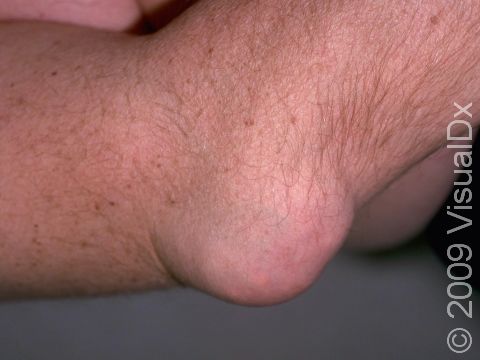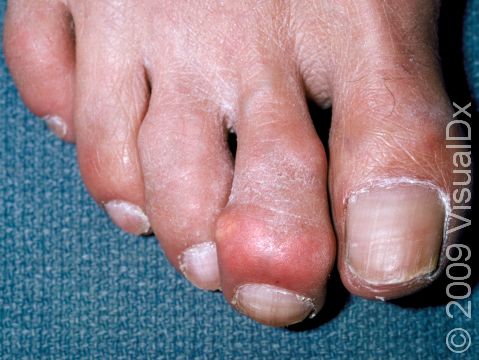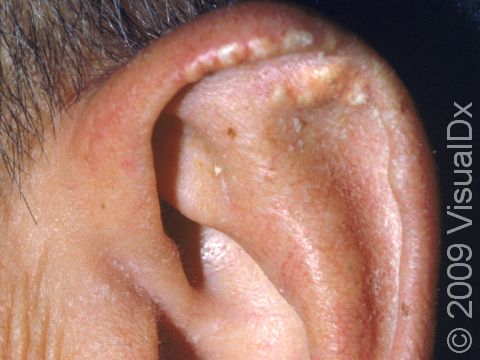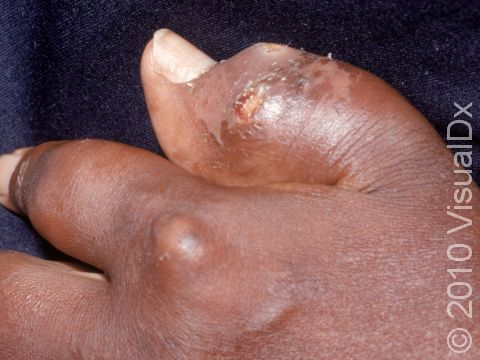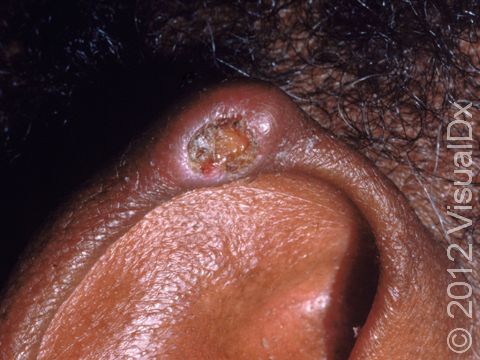Gout
Gout is a disease in which there is an elevated level of uric acid in the blood and crystals of uric acid are deposited in the cartilage and tissue surrounding joints, kidneys, and skin. These deposits cause inflammation that presents as the sudden development of a swollen, red, hot, tender joint, especially at the big (great) toe (also known as podagra), followed by the ankle, wrist, and knee, that can result in joint damage. Other signs of chronic gout are nodules (solid, raised bumps) called tophi, and kidney stones.
Uric acid is a substance resulting from the breakdown of purines (proteins found in human tissues and in many foods). Elevated uric acid is due to either increased production or decreased excretion by the kidney. The excess uric acid is deposited as needle-like crystals in the cartilage and tissue surrounding joints, in the skin, and in the kidneys.
Who's At Risk?
Gout is most common in men aged 40-50. Other people who are at highest risk of developing gout include individuals who:
- Have kidney disorders.
- Are obese.
- Consume high levels of alcohol.
- Are on certain medications (eg, diuretics).
- Have diseases of the blood, such as lymphoma, leukemia, and hemolytic anemia.
- Have chronic lead exposure.
Signs & Symptoms
The most common locations for gouty joints include the:
- Great toe.
- Ankle.
- Wrist.
- Knee.
- Elbow.
- Hand or fingers.
- Spine.
Acute gout attacks often present as the sudden development of a single painful, swollen, warm joint. The pain may be severe. A low-grade fever may also be present.
Mild attacks usually resolve quickly, but severe attacks can last days or weeks. The joint then returns to normal and is pain-free.
After a period of many years, the chronic stage of gout may develop. By this stage, the disease has caused permanent damage to affected joints and, occasionally, to the kidneys. When uric acid deposits accumulate in the skin over long periods of time, they form tophi. These tophi vary in size and are yellow or cream in color. If the tophi become very large, they can erupt through the skin and discharge a chalky, white substance. The most common locations for tophi include the:
- Rims of the ears.
- Toes and fingers.
- Achilles tendons.
- Elbows and knees.
Self-Care Guidelines
For acute attacks of gout, the following measures may help:
- Rest and elevate the affected joint, if possible.
- Apply ice packs for 20 minutes at a time, several times a day.
- Take ibuprofen for relief of pain and inflammation (unless you have a history of kidney disease or stomach ulcers), but avoid aspirin as it can worsen the condition in some people.
Individuals with gout should:
- Avoid foods high in purines such as anchovies, organ meat, red meat, asparagus, oatmeal, cocoa, mushrooms, and spinach.
- Limit alcohol consumption to 2 drinks per day for men and 1 drink per day for women.
- Consume purine-neutralizing foods such as fresh fruits (especially cherries and strawberries), most vegetables, celery juice, and B-complex and C vitamins.
- Drink an extra 4-5 glasses of water per day.
- Maintain a healthy weight.
Treatments
The goals of gout treatment are to reduce the pain associated with acute attacks, to prevent future attacks from occurring, and to avoid the formation of tophi and kidney stones.
Your medical professional may recommend one or more of the following treatments for acute attacks:
- Rest and elevation of the affected joint
- Anti-inflammatory medications, including ibuprofen, naproxen, or indomethacin
- Colchicine (an oral medication used to reduce inflammation)
- Corticosteroids (a type of anti-inflammatory medicine) such as triamcinolone injections or prednisone pills
For long-term treatment and prevention of recurrent attacks, your medical professional may recommend one or more of the following:
- A low-purine diet
- Colchicine (eg, Colcrys)
- Allopurinol (eg, Aloprim, Zyloprim) with or without lesinurad
- Febuxostat (eg, Uloric)
In rare cases, surgery may be required in the case of large tophi or to correct any joint deformities.
Visit Urgency
If you suddenly develop a painful, red, hot joint, see a medical professional. They will be able to determine if the diagnosis is gout or another serious condition, such as an infected joint.
Trusted Links
References
Bolognia J, Schaffer JV, Cerroni L. Dermatology. 4th ed. Philadelphia, PA: Elsevier; 2018.
James WD, Elston D, Treat JR, Rosenbach MA. Andrew’s Diseases of the Skin. 13th ed. Philadelphia, PA: Elsevier; 2019.
Kang S, Amagai M, Bruckner AL, et al. Fitzpatrick’s Dermatology. 9th ed. New York, NY: McGraw-Hill Education; 2019.
Last modified on June 21st, 2023 at 12:05 pm

Not sure what to look for?
Try our new Rash and Skin Condition Finder
